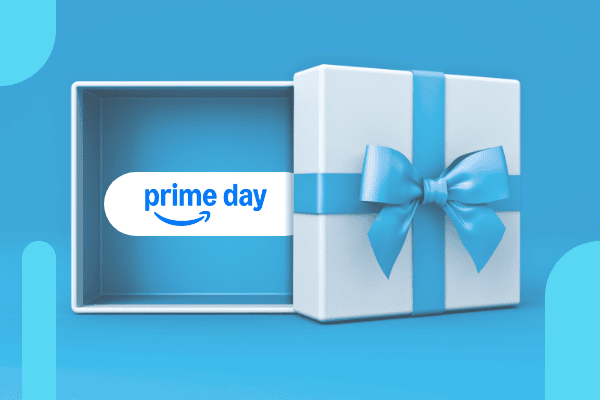Summary
Amazon’s new long-term metrics offer marketers a forward-looking lens just in time to put the finishing touches on your Prime Day plans. These insights—long-term ROAS and long-term sales—forecast the 12-month value from new-to-brand shoppers, helping brands plan smarter and optimize beyond short-term performance. With early access through Skai, advertisers can act now to turn today’s campaigns into tomorrow’s growth. “This is one of those rare moments where an early signal becomes a real strategic edge for marketers who move fast.”
Something new just dropped into the retail media mix—and it might change how you plan for the four days of Prime Day 2025 on July 8-11.
Metrics come and go, but this one could quickly become a mainstay. Amazon’s new long-term metrics shine a light on what happens after the click, after the conversion, after the campaign. It’s a new way of seeing the full impact of your ads—and it couldn’t have arrived at a better time.
Retail media is under more pressure than ever, especially as brands finalize their Prime Day strategies. Budgets are large, timelines are tight, and expectations are sky-high. But one of the hardest parts of preparing is predicting what success will actually look like. Until now, marketers have had to plan for the biggest retail moment of the summer using metrics that only look backwards.
That’s why I’m especially excited about Amazon’s newest measurement release: long-term sales and long-term ROAS. These new long-term metrics offer a forecasted view of the value your campaigns are expected to deliver over the next 12 months from new-to-brand shoppers, finally giving marketers a chance to look forward, not just back.
What makes this a bit more exciting is that these aren’t available yet with any other platform, not even in Amazon Ads’ native console. But Skai clients already have access through our platform, just in time to influence last-minute decisions for Prime Day. And while there are always new features being announced by our partners, we don’t turn them all on. It takes months or even years to prioritize what’s best for our customers. When I saw these metrics on Amazon Advertising’s roadmap, I knew immediately they were worth fast-tracking.
This is one of those rare moments where an early signal becomes a real strategic edge for marketers who move fast.
Bringing long-term value into focus for new-to-brand shoppers
- Long-term Sales: The projected 12-month sales attributed to new-to-brand customers who were influenced by your campaign.
- Long-term ROAS: The projected 12-month return on ad spend based on the same new-to-brand customer interactions.
Important Note – Right now, supported formats include Sponsored Display, Sponsored Brands, Sponsored TV, and Amazon DSP—so you’ve got flexibility across your mid- and upper-funnel tactics.
Long-term sales and ROAS are forecasted metrics built using Amazon’s own first-party data and machine learning models. They estimate the 12-month downstream value of NTB (new-to-brand) shoppers who engage with your ads, offering a window into what kind of customer you’re actually acquiring.
This release comes at a pivotal time. As commerce media becomes more central to marketing strategy, the need for consistent, future-facing metrics is growing. Skai’s 2025 State of Retail Media report found that only 48% of marketers feel confident in their forecasting abilities, despite 68% calling it essential to full-funnel planning.
If planning is a forward-looking exercise, then marketers need forward-looking data. Most retail media metrics still focus on short-term iROAS and immediate conversions. That’s helpful, but it’s only half the story. Amazon’s long-term metrics are grounded in the company’s unique shopper visibility, making them one of the most credible forecast sources available for retail media. These aren’t hypothetical models—they’re built on the collective behaviors of millions of shoppers across browsing, add-to-cart actions, and purchases.
That unlocks more strategic questions: What kind of value will this campaign drive next quarter? Will these shoppers buy again? Which campaign is quietly turning browsers into loyalists? With long-term ROAS, brands can rebalance spend not just on what’s working now, but on what will work longer.
How to use Amazon’s long-term metrics for Prime Day
These metrics will soon become some of your most often-used indicators. But right now, Prime Day is the perfect opportunity to put them into play, learn how they behave, and figure out how to fold them into your planning process moving forward.
Campaign targeting high funnel NTB shoppers? Look for strong long-term ROAS before Prime Day to identify efforts likely to pay off down the road—even if 14-day ROAS looks soft. For example, a Sponsored Display campaign with a long-term ROAS of 2.5 but short-term ROAS of 0.6 might seem inefficient at first glance. But with these new insights, you know it’s likely driving loyal future customers. Consider keeping spend steady or even increasing it slightly to lock in value early.
Running campaigns mid-event? Compare your short-term and long-term ROAS to evaluate which ads are generating loyal customers versus one-and-done conversions. A mid-funnel campaign might show a quick return but low long-term projections. Meanwhile, another campaign with a slower immediate payback could indicate it’s building stronger downstream impact. Use this intel to shift in-flight budgets or push more visibility toward the long-term winners.
Post-event wrap-up? Use long-term ROAS and sales metrics as part of your retrospective to assess campaign quality. Don’t just ask what drove conversions—ask what built momentum. For example, you might find that Sponsored TV drove fewer sales during Prime Day itself, but shows strong 12-month projections. That makes it a high-value acquisition channel you should consider sustaining or scaling.
What to know about Amazon’s long-term metrics
It’s important for marketers to really understand their metrics deeply, especially when they’re new. Long-term metrics offer a new perspective, but only if you understand how they work and what to expect.
Here’s what you need to know now:
- Designed for NTB measurement only: These metrics focus exclusively on the future value of new-to-brand shopper interactions. They aren’t meant to reflect the full performance of a campaign but to spotlight its future potential.
- Forecast, not actualized: Amazon calculates these using return-on-engagement models plus 14-day attributed sales. They combine historical behavior patterns with recent campaign interactions to predict 12-month value.
- Only available on a subset of campaign types: Supported formats include Sponsored Display, Sponsored Brands, Sponsored TV, and Amazon DSP. Sponsored Products are not eligible.
- Require minimum campaign activity: Campaigns must meet Amazon’s minimum thresholds: 12 months of activity, 30+ orders per month, and 4.5K+ detail page views per month.
- Only available through select platforms: Right now, Skai clients can see these directly in the campaign grid. Amazon hasn’t released them in the native console, and most other platforms don’t have access yet.
- More info? Check out this Amazon Ads Support Center article.
Understanding the context behind these metrics helps you use them more effectively. Whether you’re comparing campaigns or building a longer-term acquisition strategy, it’s critical to know exactly what you’re looking at.
Making the most of long-term metrics inside Skai
When new metrics like these are released, they don’t just add to the data set—they unlock entirely new ways to analyze, automate, and optimize. That’s where the real advantage of using Skai comes in: the ability to layer these insights across other signals, trigger actions off of them, and make them work harder inside a connected retail media strategy.
Layered insights with custom metrics: Long-term ROAS and sales don’t live in isolation. Inside Skai, you can combine them with other KPIs, such as NTB rates, product-level performance, or even share-of-voice data, to build a more comprehensive picture. For example, marketers can create calculated metrics that compare forecasted ROAS with actuals or build dashboards highlighting campaigns likely to grow customer LTV.
Actionable automation: Skai doesn’t just help you see what’s happening — we help you do something about it. Long-term metrics can feed into automated rules, pacing strategies, or custom bidding logic. Want to boost budgets for campaigns with >2.0 long-term ROAS and a sub-1.0 short-term ROAS? That’s entirely possible.
Smart alerting: When long-term metrics trend up or down, Skai can notify you with custom alerts, built to your definitions of success. Get notified when campaigns drop below the threshold or spike in value, so you can stay proactive in your optimizations.
Measurement experimentation: If you’re running incrementality tests or custom lift studies, long-term ROAS adds another layer of context. Use it to evaluate not just short-term lift but enduring shopper value.
Unified reporting: Fold these metrics into your cross-retailer dashboards. With Skai, you can monitor long-term performance across Amazon and other major retailers in one place, making it easier to compare strategies and standardize benchmarks.
Conclusion: Try these new metrics for Prime Day!
Amazon’s long-term metrics are here, and they’re changing how we plan, assess, and optimize retail media. From the ability to forecast future customer value to seeing which campaigns build long-term loyalty, this update represents a real shift in how we define success.
Use them now for Prime Day, and you’ll not only drive better outcomes but also gain first-hand experience applying them before they become table stakes. It’s a chance to build smarter campaigns and get sharper insights.
What makes this even more exciting is the exclusivity. These aren’t available in the Amazon Ads console yet, but Skai clients already have them in-platform. It’s another example of how Skai stays ahead to help brands thrive in a fast-moving commerce media world.
We invite you to schedule a demo and see how Skai can help you activate these metrics, automate around them, and integrate them into your strategic commerce media program.
Frequently Asked Questions
Long-term sales and long-term ROAS are a forecast of ad return over 12 months from new-to-brand shoppers. It helps measure lasting value beyond initial conversions.
It shows which campaigns drive future value, not just immediate sales. Use it to shift spend to ads to build loyal customer relationships.
Long-term sales and long-term ROAS help forecast customer value over time, not just immediate sales. It supports smarter budgeting and aligns full-funnel and commerce media strategies.
Customer Long-Term Value is a calculation that helps you understand the extended value of converting a net-new customer. Amazon has standardized its approach to CLTV, utilizing long-term sales and long-term ROAS metrics to simplify media planning and activation. These metrics can be accessed through Skai to help you automate and optimize at scale for the best long-term return on your advertising investment.







